LG G2 and MSM8974 Snapdragon 800 - Mini Review
by Brian Klug on September 7, 2013 1:11 AM EST- Posted in
- Smartphones
- LG
- Mobile
- LG G2
- Android 4.2
- MSM8974
- Snapdragon 800
Battery Life
One of the things Qualcomm promised would come with Snapdragon 800 (8974) (and by extension the process improvement with 28nm HPM) was lower power consumption, especially versus Snapdragon 600 (8064). There are improvements throughout the overall Snapdragon 800 platform which help as well, newer PMIC (PM8941) and that newer modem block onboard as well, but overall platform power goes down in the lower performance states for Snapdragon 800. In addition the G2 has a few unique power saving features of its own, including display GRAM (Graphics RAM) which enables the equivalent of panel self refresh for the display. When the display is static, the G2 can run parts of the display subsystem and AP off and save power, which they purport increases the mixed use battery life case by 10 percent overall, and 26 percent compared to the actively refreshing display equivalent. In addition the G2 has a fairly sizable 3000 mAh 3.8V (11.4 watt-hour) battery which is stacked to get the most out of the rounded shape of the device, and utilizes LG's new SiO+ anode for increased energy density compared to the conventional graphite anode.
Our battery life test is unchanged, we calibrate the display to exactly 200 nits and run it through a controlled workload consisting of a dozen or so popular pages and articles with pauses in between until the device dies. This is repeated on cellular and WiFi, in this case since we have an international model of the G2 that lacks the LTE bands used in the USA, that's 3G WCDMA on AT&T's Band 2 network. I've tested 3G battery life on devices concurrently for a while now in addition to LTE though, so we still have some meaningful comparisons. The most interesting comparisons are to the Optimus G (APQ8064) and HTC One (APQ8064T) previous generation.
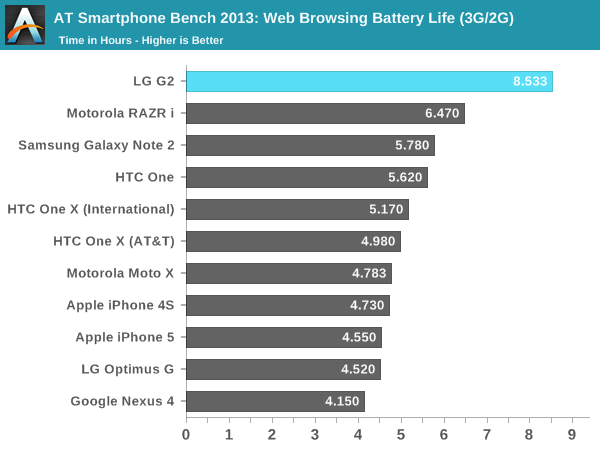
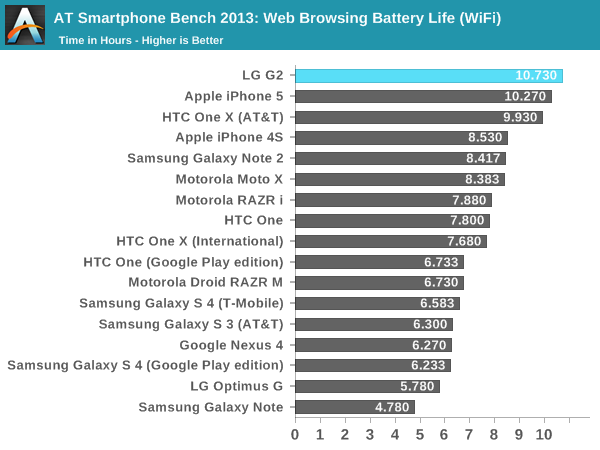
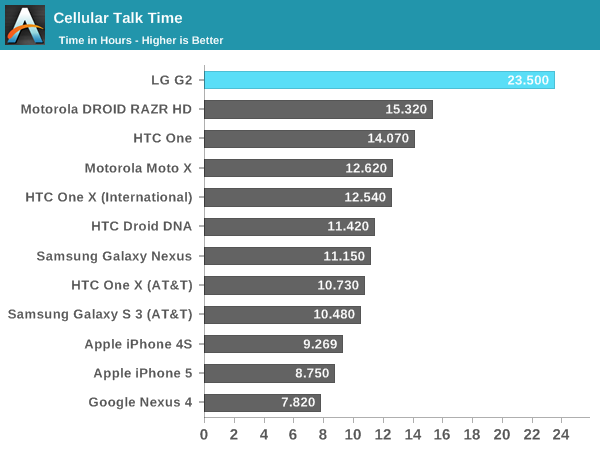
The LG G2 battery life is shockingly good through our tests, and in subjective use. The combination of larger battery, GRAM for panel self refresh, new HK-MG process, and changes to the architecture dramatically improve things for the G2 over the Optimus G. While running the two web browsing tests I suspected that the G2 might be my first phone call test to break 24 hours, while it doesn't break it it comes tantalizingly close at 23.5 hours. I'm very impressed with the G2 battery life.
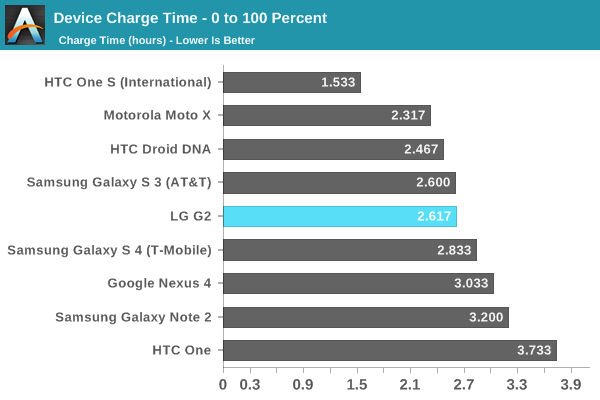
The G2 also charges very fast for its battery size. I've been profiling charging behavior and current for devices for a while now, since I strongly believe that battery life and charging speed are complementary problems. You should always opportunistically charge your smartphone, being able to draw as much while you have access to a power outlet is critical. The G2 can negotiate a 2A charge rate on my downstream charge port controller and charges very fast in that mode. Of course the PM8941 PMIC also includes some new features that Qualcomm has given QuickCharge 2.0 branding.


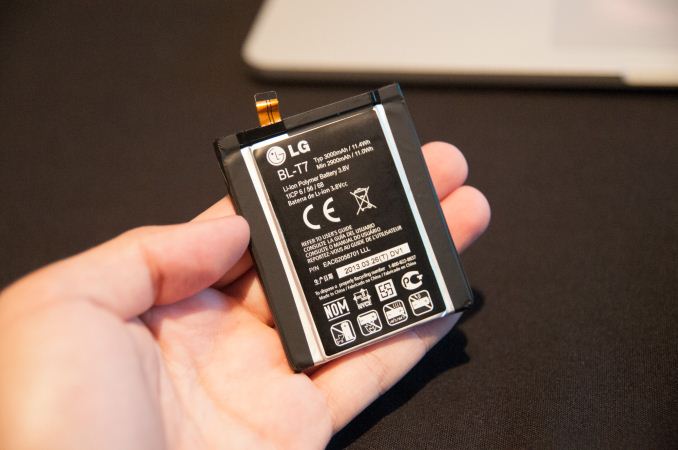








120 Comments
View All Comments
neoraiden - Sunday, September 8, 2013 - link
I was considering the qx100 but the price is out of my range as I don't take enough photographs to spend that much, am considering the qx10 though at that price point I wonder if a canon 240hs would suffice.Arnulf - Saturday, September 7, 2013 - link
"Gone are the days of 1.4V to hit near-2GHz frequencies it seems, instead 8974 will hit 2.3 GHz at around 1V"About fuggin time - my 2006 vintage 65 nm Core2 runs at 2.13 GHz at less than 1.1V. I was under the impression that smaller lithography process allows for lower voltages so they should have been well under 0.9V for 2 GHz by now.
Drumsticks - Saturday, September 7, 2013 - link
You are comparing two different companies' completely different CPUs, ARM vs x86 too. My 4670k will do 4ghz stable on a volt. The nature of smartphone SoCs vs full CPUs is very differentmadmilk - Saturday, September 7, 2013 - link
Your Core 2 also consumes 10 watts idling, despite the use of high-k dielectrics that TSMC only recently started using. HP trades off leakage for high clock speeds and low voltages.FwFred - Saturday, September 7, 2013 - link
You are comparing a platform with 3 discrete chips instead of one, and way more high voltage IO interfaces. Try a modern x86 SoC: Haswell ULT, Bay Trail, or Clover trail for a more fair comparison for idle power.His point was top clock speed vs. voltage. A completely different topic.
Krysto - Sunday, September 8, 2013 - link
From what I've read, it's becoming very hard to use the same litography process at smaller nodes, and they need to move to a new litography technology (ultraviolet litography, I think), but that's years away from being ready, too, and might not be until 14nm or even 10nm.unipidity - Saturday, September 7, 2013 - link
I would just like to comment that articles like this are one of the reasons Anandtech will continue to get my traffic long into the future. Brian's "mini-review" is head and shoulders above any "full" review I come across on most tech review sites. Anandtech is never ever first to print, at least on phones, but when it comes to properly informing my purchasing decisions, nothing comes else comes close. Keep up the good work.Impulses - Saturday, September 7, 2013 - link
+1000UltraWide - Saturday, September 7, 2013 - link
Why are the comparison devices different throughout the tests?This inconsistency makes it hard to compare the G2 to another device.
nerd1 - Saturday, September 7, 2013 - link
Funny fact is the domestic version of G2 supports both microSD and switchable battery (albeit slight smaller). Obviously US customers are too tamed to apple devices and they won't need such features.